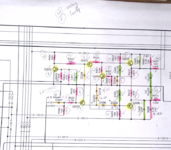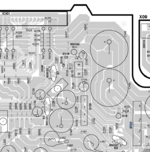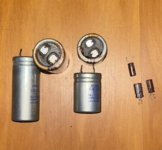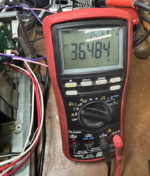Spent last evening to find parts ... not an easy job! The amplifier is more or less 22-24 years old.
This evening was spent starting at the very beginning of the circuit. The mains transformer. I worked through the schematic and found that the rectifier D121 circuit (yellow) must be supplied with a voltage higher than the 76V it must deliver and the circuit for rectifier D122 (red) with something more than the 46V required.

It took some time to figure out the correct order of the transformer pins that lead to these two rectifiers. No use looking at the circuit diagram and counting pins. It is not in the same order as indicated on the diagram!
I finally figured it out and measured the voltages between the pins as indicated in the figure below.
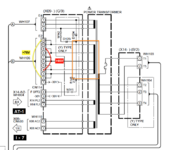
It was not even close to the two indicated values. The other pins also did not deliver the correct voltages but not with such a large deviation. I pondered and then pondered some more. The only thing left was that the transformer is faulty or the circuit downstream from the pesky ribbon cables were pulling the output down.
Sigh and sigh and the digging deep for some courage I decided to desolder these once again. Sigh again ...
Alas, no difference. Why would a transformer become faulty? This one looked good and not hot spots were visible. The only thing left was that the transformer either received an incorrect voltage or the output pins I measured on received the wrong voltage.
I took out my big soldering iron and resoldered all the transformer wire connections. Wires onto the pins and pins onto the PCBs.
Connected AC once again and measured. Perfect voltages now! Both 20% more that the values stated. There we are!
A working transformer! PCBs need a clean once I have resoldered the ribbon cables.

Just shows again that age will oxidise solder thus creating bad joints! Guess I will have to resolder all the joints on the PCBs ...
